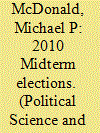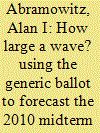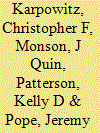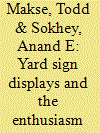| Srl | Item |
| 1 |
ID:
105422


|
|
|
|
|
| Publication |
2011.
|
| Summary/Abstract |
The 2010 midterm elections are consequential not only in terms of the candidates who were elected to office, but also in terms of the government policies that they will enact. High on the list of important policies is the decennial practice of drawing new redistricting plans for legislative offices. A new census reveals population shifts that will result in a reallocation of congressional seats among the states through apportionment and-following U.S. Supreme Court rulings in the 1960s-a re-balancing of congressional and state legislative district populations within states that aims to give fast-growing areas more representation and slow-growing areas less. Of course, much more than an innocuous administrative adjustment occurs during the process of redistricting. The individuals who draw districts are keenly aware that district lines may affect the fortunes of incumbents, political parties, and minority voters' candidates of choice.
|
|
|
|
|
|
|
|
|
|
|
|
|
|
|
|
| 2 |
ID:
100776


|
|
|
|
|
| Publication |
2010.
|
| Summary/Abstract |
As Election Day approaches, many political commentators are asking whether the 2010 midterm elections could be a reprise of 1994, when Republicans picked up eight seats in the Senate and 52 seats in the House of Representatives to take control of both chambers for the first time in 40 years. There is almost universal agreement that Republicans are poised to make major gains in both the House and the Senate. And while the GOP's chances of gaining the 10 seats needed to take control of the upper chamber appear remote, results from the generic ballot forecasting model indicate that the 39 seats required to take back the House of Representatives are well within reach.
|
|
|
|
|
|
|
|
|
|
|
|
|
|
|
|
| 3 |
ID:
105421


|
|
|
|
|
| Publication |
2011.
|
| Summary/Abstract |
By winning the presidency and strengthening its majority in both chambers of Congress, the 2008 election gave control of the government to the Democratic Party. However, as the 2010 election season unfolded, the news for the Democratic Party could not have been much worse. Economic conditions had not improved dramatically. A bitter and lengthy fight over health care reform signaled to citizens that little had changed in how Washington, DC, governed. The stimulus package and its impact on the federal debt caused unease in a segment of the electorate that was concerned with the size of government. In this context, observers of American politics began to take note of the number of citizens affiliating with, or at least expressing favorability toward, a loose coalition of groups known as the Tea Party movement. Tea Party rallies began to occur throughout the United States, seeking to draw attention to the movement's primary issues.
|
|
|
|
|
|
|
|
|
|
|
|
|
|
|
|
| 4 |
ID:
116469


|
|
|
|
|
| Publication |
2012.
|
| Summary/Abstract |
In the run up to the 2010 midterm elections, pundits and politicos often talked of an "enthusiasm gap" between Republicans and Democrats. Although conventional treatments have typically equated these gaps with changes in turnout and the composition of the electorate, we argue that the term better describes the participatory patterns of highly engaged voters. Using multiple data sources, including a geocoded, county-wide study that tracked yard sign displays between 2008 and 2010, we examine the visible evidence of enthusiasm gaps in voters' neighborhoods. Our findings echo recent narratives, yet suggest that scholars have missed important dimensions in their examinations of these "wave" elections.
|
|
|
|
|
|
|
|
|
|
|
|
|
|
|
|